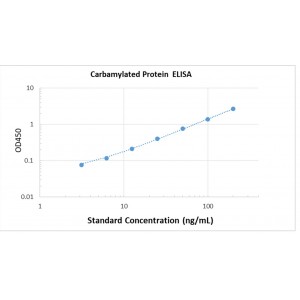Data sheet
| Background | Carbamylation is a post-translational modification which occurs throughout the lifespan of proteins in vivo. Carbamylation results from the binding of isocyanic acid, spontaneously derived from high concentrations of urea and leading to the formation of carbamyl-lysine. The carbamylation of proteins is usually associated with a partial or complete loss of protein function. It is known that elevated urea directly induces the formation of potentially atherogenic carbamylated LDL (cLDL). High blood concentrations of urea leading to the carbamylation process were detected in uremic patients and patients with end-stage renal disease. isocyanic acid is a decomposition product of urea. Isocyanic acid levels, while low in vivo, are in equilibrium with urea, and are thus increased in chronic and end-stage renal diseases. An alternative pathway involves the leukocyte haem protein myeloperoxidase, which catalyses the oxidation of thiocyanate in the presence of hydrogen peroxide, producing isocyanate at inflammation sites, like the joint area of RA patients. Increased protein carbamylation, result in increase of autoantibody against the carbamylated proteins. Anti-Carbamylated antibody has been associated with the progression of the RA disease. |
| Assay Type | Sandwich ELISA |
| Kit Type | Colorimetric |
| Assay Time | 3.5 hours |
| Sample Type | Serum, Plasma |
| Assay Range | 3.12 - 200 ng/mL |
| Sensitivity | 0.51 ng/mL |
| Sample Volume | 100 uL |
| Dilution Factors | 1 to 50 or 1:100 dilution |
| Storage | 2 - 8 ºC |
More info
Related Products:
1. Human Anti-Carbamylated Protein Antibody, ( Anti-CarP) ELISA Kit, Cat#: BG-HUM09021
2. Carbamylated BSA, Cat#PR-C1001
3. Rabbit Anti-Carbamylated-Lysine Polyclonal Antibody, Cat#AB-09021R
Several proteins have been demonstrated to undergo carbamylation in different pathophysiological conditions, often altering their structure and rendering them dysfunctional. Long-lived proteins are particularly prone to PTMs such as carbamylation, which are considered the hallmark of molecular aging. Carbamylation of a-crystallins induces conformational changes responsible for lens opacities in cataract. In addition, carbamylation disturbs the triple helix structure of collagen type I, leading to a decreased ability to polymerize into normal fibrils and increased susceptibility to collagenases. Furthermore, enzymatic activity of insulin and erythropoietin are substantially diminished after carbamylation. Interestingly, carbamylation has also been shown to be potentially involved in the pathogenesis of rheumatoid arthritis, where in animal models carbamylated peptides were shown to serve as a potent neo-antigen for production of autoantibodies and an erosive arthritis phenotype. Importantly, recent studies also show protein carbamylation occurs at increased levels within atherosclerotic plaques1, and alternative studies suggest that protein carbamylation may play a role in Alzheimer disease development through the generation of abnormal tau protein deposits in the brain.


